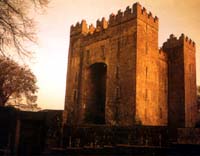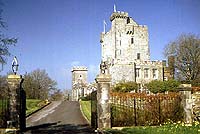Vacation Guide
Ireland golf vacation guide : To do and see
CLARE
 Bunratty Castle & Folk Park – situated near Newmarket-on-Fergus, Bunratty Castle and Folk Park helps re-create ancient life in a festival of Irish music, dancing and song as medieval banquets are held. The park comprises a number of traders such as blacksmiths and shopkeepers, each plying their trade using traditional methods. Visitors are encouraged to sample the food and assist in the cooking as a means of understanding life in 17th century Ireland.
Bunratty Castle & Folk Park – situated near Newmarket-on-Fergus, Bunratty Castle and Folk Park helps re-create ancient life in a festival of Irish music, dancing and song as medieval banquets are held. The park comprises a number of traders such as blacksmiths and shopkeepers, each plying their trade using traditional methods. Visitors are encouraged to sample the food and assist in the cooking as a means of understanding life in 17th century Ireland.
 Cliffs of Moher – located near Liscannor, the majestic Cliffs of Moher is one of Ireland’s most famous and beautiful tourist attractions. Five miles of dramatic cliff tops offer superb views, while its sheer cliff-face, comprising black shale and sandstone, plunge some 700 feet into the raging Atlantic below. The cliffs are also renowned for their extensive bird colonies.
Cliffs of Moher – located near Liscannor, the majestic Cliffs of Moher is one of Ireland’s most famous and beautiful tourist attractions. Five miles of dramatic cliff tops offer superb views, while its sheer cliff-face, comprising black shale and sandstone, plunge some 700 feet into the raging Atlantic below. The cliffs are also renowned for their extensive bird colonies.
Craggaunowen Project – situated in mid Clare near the village of Quin, the exceptionally interesting Craggaunowen Project recalls life in the county from the Bronze Age to the Middle Ages and also the role of crannóg construction in lake based communities in early Ireland.
Cratloe Woods – located close to Limerick, Cratloe Woods offers a unique opportunity to see the last inhabited example of an Irish longhouse, a type of building that has almost disappeared. The 17th century house belongs to a descendent of Brian Boru and contains family portraits, an array of other works of art and a collection of antique farm machinery.
Doolin Village – located just a few miles from the Cliffs of Moher, Doolin is a beautiful small fishing village, which today is famous as a place of pilgrimage for traditional music lovers. Thousands of visitors gather each year to sample the region’s heritage of song, dance, and instrumental music.
Dysert O’Dea – situated on the route from Ennis to Corofin, this is the site of the monastic settlement founded by St. Tola in the 7th century and the scene of a famous battle in 1318, when the O’Brien clan vanquished the de Clares of Bunratty, thereby preventing an Anglo-Norman takeover of the county.
Ennis Friary – situated in the thriving market town of Ennis, which straddles the River Fergus, this mediaeval monastery was founded in 1242 by the O’Brien clan, kings of Thomond. Now in ruins, the friary contains a number of interesting sculptures and decorated tombs.
Inchiquin Castle – located near Corofin and set on the northern shores of Lough Inchiquin, the castle was built in the 15th century. Though in ruins, part of the old castle tower can still be seen and a portion of the banqueting hall remains intact.
 Knappogue Castle – located near the town of Ennis, just two miles east of Quin Village, Knappogue Castle dates back to 1467 and has been painstakingly restored and transformed into a splendid venue for mediaeval banquets and Irish historical evenings.
Knappogue Castle – located near the town of Ennis, just two miles east of Quin Village, Knappogue Castle dates back to 1467 and has been painstakingly restored and transformed into a splendid venue for mediaeval banquets and Irish historical evenings.
Moghane Hill-Fort – set in the grounds of Dromoland Castle is one of the most extensive hill-forts in Ireland, with several acres encompassed with its walls. Dating back to 500 BC, this prehistoric village has fortifications that are up to 23 feet thick in places. A number of Bronze Age adornments were found in March 1854 and are on display at the Royal Irish Academy.
O’Connell Monument – located in Ennis Town, the monument stands as an appropriate tribute to the "Liberator", Daniel O’Connell, who despite the ban on Catholic MP’s, was returned by such a huge majority by the people of Clare, that it was impossible to prevent him from taking his seat in the House of Commons.
Quin Village – lying to the east of Ennis, Quin is an old-world village with a well-preserved Franciscan friary, founded in 1433. Monks continued to live here up to the 19th century. Beside the friary is the 13th century church of St. Finnéan.
The Burren – a natural wonder famed across the world for its beauty, the Burren is a unique array of flora, fauna, butterflies and rock. The Burren Display Centre at Kilfenora explains how the Burren was formed and helps identify the fauna that you will encounter.



